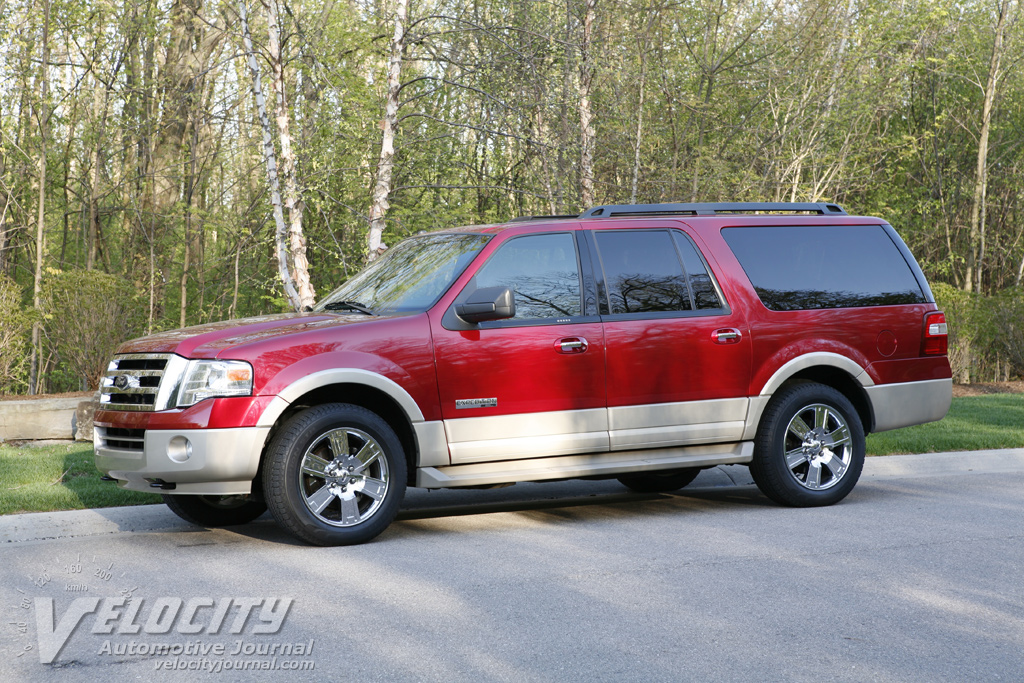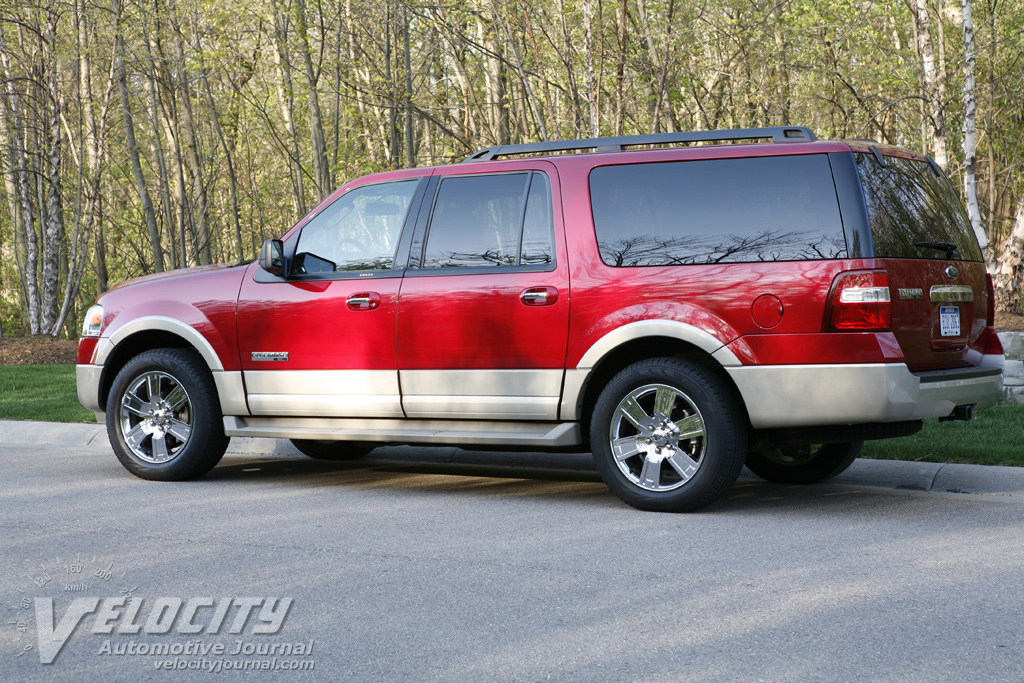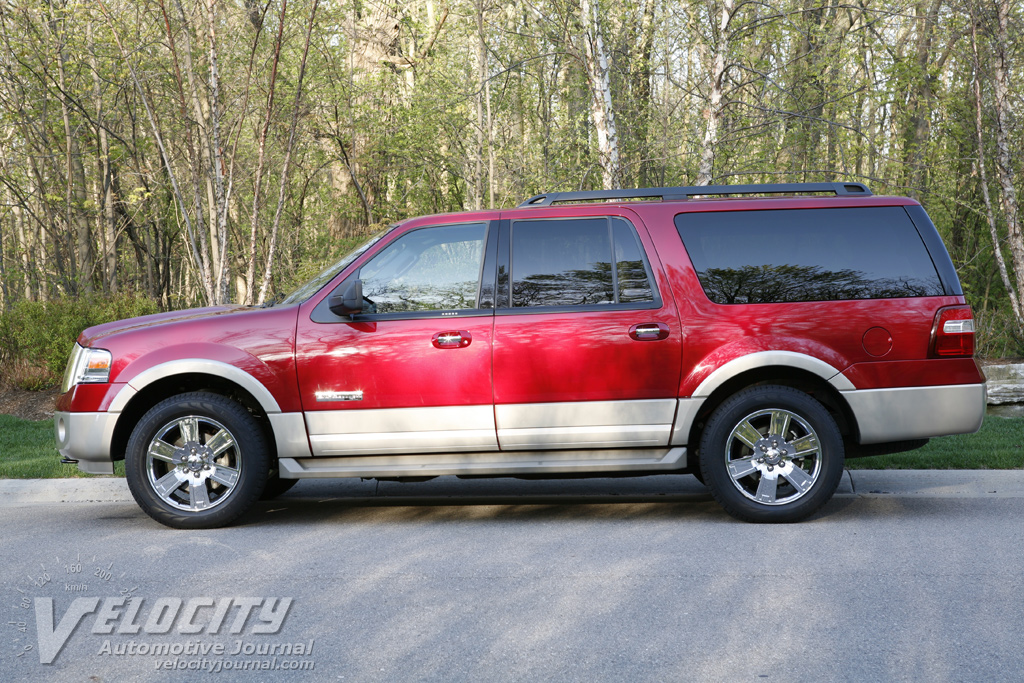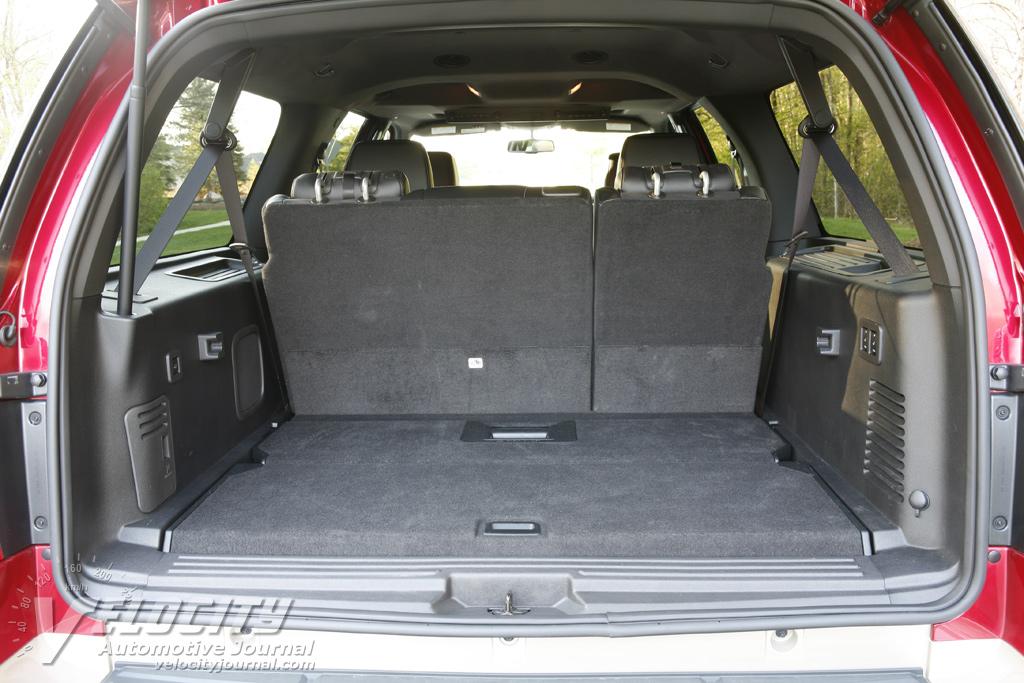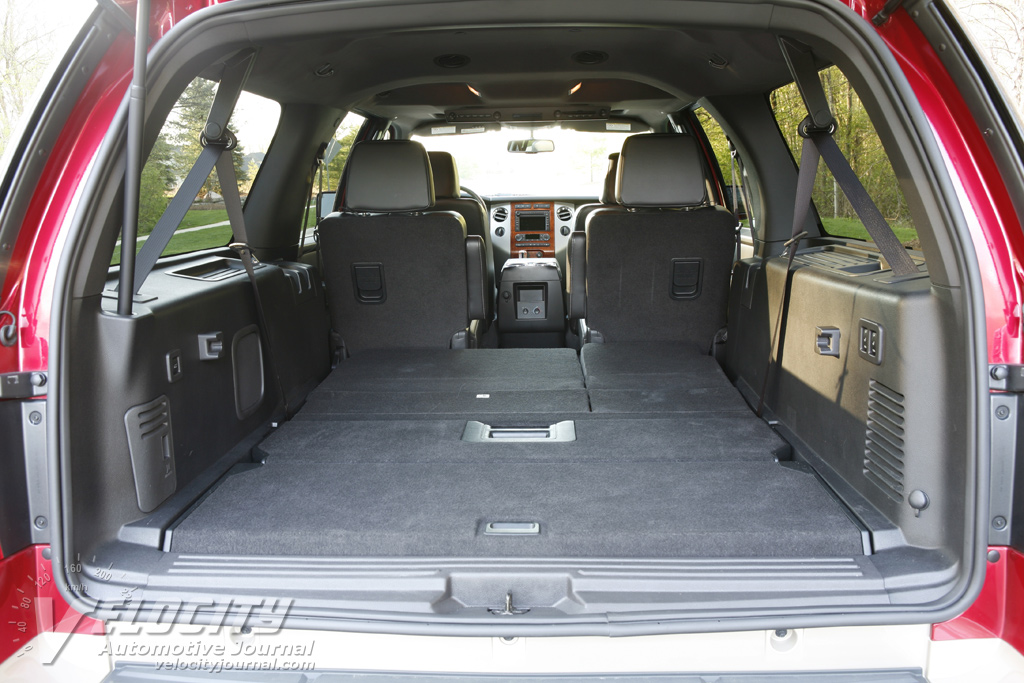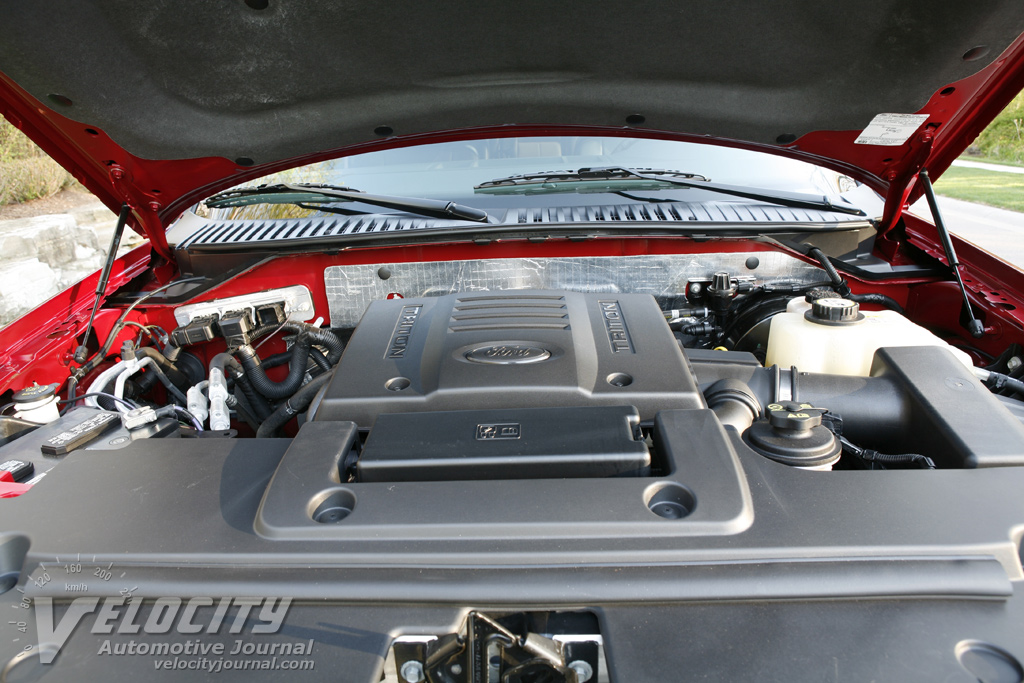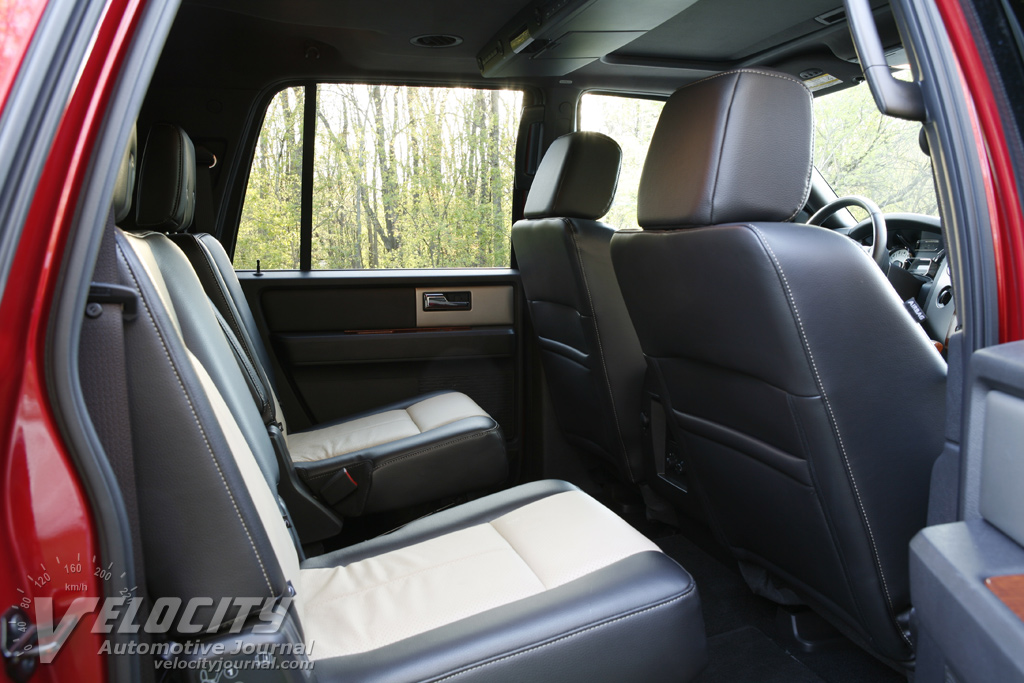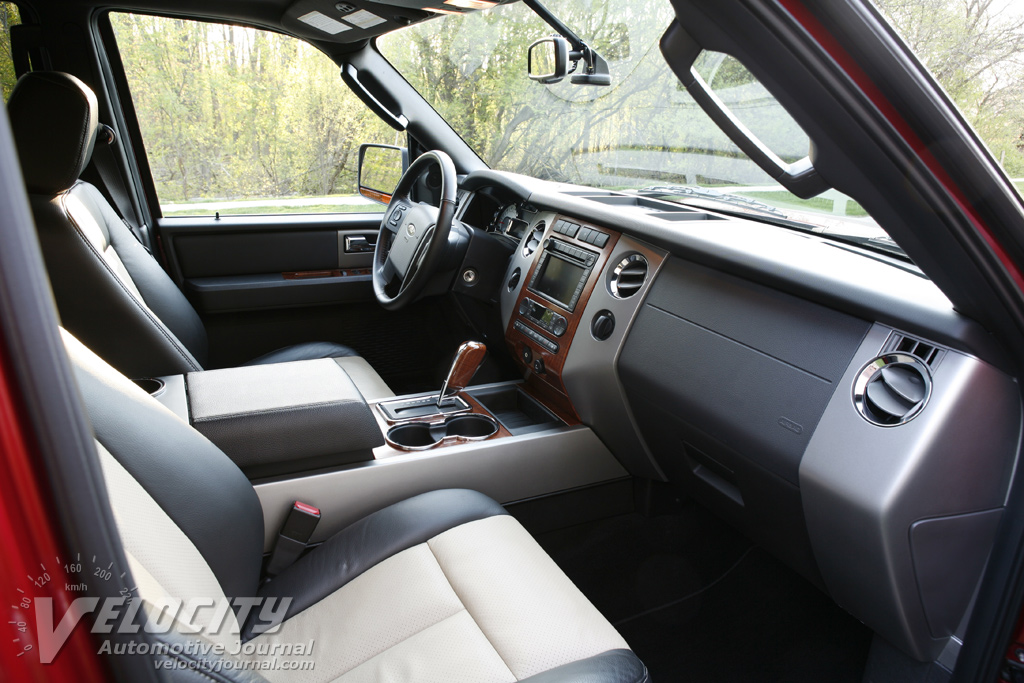2007 Ford Expedition Eddie Bauer EL 4 x 4
05/10/2007
Shahed Hussain
Ford has had its sights set on the iconic Chevrolet Suburban for years. Ironically, the Excursion, Ford's first attempt to siphon sales from its rival, was too big to fit into most garages. More importantly, the Excursion faced the wrath of anti-SUV zealots for its gluttonous fuel appetite and sheer bulk. Ford learned from that public relations fiasco, and wisely introduced the 2007 Expedition EL with little fanfare. According to Ford's internal research, 92% of current Expedition owners use their SUV for vacations, 60% haul sports gear, and 84% regularly carry more than three passengers in the 2nd and 3rd row seats. These customers will appreciate the extra 24 cu. ft. of cargo space behind the 3rd row seat that the Expedition EL offers over standard Expedition.
We drove a 2007 Expedition Eddie Bauer EL 4 x 4, painted in an attractive Redfire Metallic. The Eddie Bauer is the midlevel model; bracketed by the base XLT and the top of the line Limited trim levels. Although the base Eddie Bauer 4 x 4 starts at a reasonable $41,125, our test vehicle was heavily loaded with options such as the 20-inch chrome-clad alloy wheels and P275/55R20 Pirelli Scorpion STR tires ($1,095), second row captain's chairs ($795), skid plate package ($100), power moonroof ($950), convenience package ($675), heavy duty trailer tow ($350), navigation system ($1,995), power liftgate (($495), Sirius satellite radio ($195), rear load-leveling suspension ($485), climate controlled seats ($625), rear seat DVD entertainment ($1,500), and a chrome exhaust pipe tip ($75). The grand total for this option-laden Expedition EL is a hefty $51,280 (including $820 destination charge).
So how well does the Expedition EL match up to Suburban? Let's look at exterior dimensions for a start. The Ford's wheelbase of 131" stretches an inch longer than the Chevy, while its 221.3" overall length is 1.1" shorter. In width, the Ford at 78.8" is 0.3" narrower compared to the Chevy. For overall height, the Expedition EL is slightly taller at 78.3" vs. 76.8" for the Suburban. The Suburban 1500 (5,745 lbs.) and 2500 (6,328 lbs.) models bracket the Expedition EL, which weighs in at 6,053 lbs. Full-size SUV owners often tow massive boats and trailers, so powertrain options often weigh heavily in their decision. Ford equips the Expedition EL with its popular 5.4L V-8 and 6-speed automatic. This iron-block/aluminum head SOHC V-8 cranks out 300-bhp @ 5,000 RPM and 365 lb.-ft. @ 3,750 RPM. The Suburban offers a choice of engines mated to a 4-speed automatic, ranging from a 310-bhp/335 lb.-ft. 5.3L V-8, to a 6.0L V-8 with 366-bhp/380 lb.-ft. For heavy duty towing and cargo hauling, torque rules, but the 4% additional torque in the 6.0L Chevy is a negligible difference. Where the Expedition differentiates itself is with the 6-speed transmission's wider ratio spread, which allows a shorter 1st gear ratio for better towing performance at low speeds, plus the taller 6th gear aids fuel economy.
We didn't do any hauling with Expedition EL, as most of the time we had no more than one passenger. Ford rates the 4 x 4 Expedition EL to tow up to 8,750 lbs., with a payload rating of 1,775 lbs. The 5.4 V-8 has reasonable grunt when lightly loaded, while the 6-speed automatic shifts seamlessly. Engine noise is insignificant except at full throttle, where the V-8 makes itself heard, although it never sounds like it is working hard. Because the Expedition EL exceeds the maximum GVWR for EPA fuel consumption tests, the window sticker has no gas mileage estimates. For reference, a 4 x 2 Expedition gets an EPA 14/20 MPG (city/hwy.) rating equipped with the same 5.4L/6-speed combination. Since the 4 x 4 Expedition EL outweighs the 4 x 2 non-EL model by 475 lbs., you can probably expect a 1-2 MPG reduction over the 2WD Expedition. Unfortunately, we didn't rack up enough miles on our test vehicle to get an accurate overall fuel consumption estimate.
The Expedition EL shares its interior design with its short wheelbase cousin, so materials and trim fits are generally above average. We do wish that Ford didn't use so much hard plastic on the dashboard, but at least they are high quality, attractively grained polymers. A comprehensive set of gauges include a tachometer, speedometer, as well as smaller gauges for the coolant temperature, oil temperature, volt meter, and fuel level. Bright chrome trim surrounds the black-on-gold faced instrument bezels. The fat leather-wrapped steering wheel has integrated audio, cruise, fan speed, and temperature controls on the spokes. Although steering wheel-mounted audio and cruise controls are commonplace, fan speed and temperature controls are unusual. The wood appliques on the center console, HVAC controls, shift lever, and door armrests have convincing enough depth and gloss to fool the casual observer, but reveal their plastic origins upon close examination. An LCD touch screen and surrounding buttons control the HVAC, audio, and navigation systems. We found the navigation and audio interface overly complex. Too many functions were concentrated on the touch screen, which lacked tactile feel. For example, there is no dedicated map zoom button for the navigation system. Instead, small triangular virtual buttons on the touch screen control the zooming function. Audio sources or radio stations are also selected via the touch screen. Unfortunately, the touch screen buttons requires the driver to look away from the road to adjust basic audio functions, which we found to be unnecessarily distracting.
A rotary button next to the steering column selects the 4WD mode between "4H" (4WD High), "4A" (4WD Automatic), and "4L" (4WD Low). We left the setting on "4A" since we spent all our time on paved roads. On the lower left side of the dash is a rocker switch to control the power adjustable pedals. This feature is especially useful for shorter drivers who may have trouble reaching the pedals otherwise. Even average sized adults will appreciate the extra adjustability, because the seat position is less dependent on the pedals location. Below the HVAC controls is an audio input and 12V power outlet for an MP3 player. Ford thoughtfully includes a line-in cable, stored in the center console box. A second 12V outlet sits above the glove box near the front passenger seat. Dual cupholders sit next to the shift lever between the front seats. An additional pair of cupholders is behind the console storage compartment. Two storage bins, one on the center console and the other on top of the dashboard provide ample room to hide valuables. Next to the overhead sunroof controls is a switch to open the rear hatch window.
The Eddie Bauer package includes 10-way power front seats upholstered in dark gray/beige two-tone leather. A seat memory function automatically slides it back when the ignition key is removed for easier egress. Overall front seat support and comfort are decent, although the thigh bolsters are flatter than we would like. However, the flat seats make it easy to step down out of the vehicle. Perforated leather upholstery allows the hidden cooling fans to circulate air between the seat surface and your body. We found the optional ventilated seats quite effective at removing sweat-induced dampness from our clothes.
Second row seat comfort is better than average, with excellent headroom and reasonable legroom for passengers up to 6 ft. tall. For added comfort, the 2nd row seats have folding armrests, and will even recline back far enough to take a nap. Surprisingly, getting to the 3rd row seats doesn't require any contortions, as the center aisle is wide enough for most adults. Once you're back there, the seats are reasonably comfortable for two passengers, but cramped for three. Headroom and legroom are adequate for passengers up to 6' tall. We wouldn't recommend long journeys in the 3rd row seats, but they are certainly acceptable for short trips. The cargo area behind the seats has a carpeted shelf/divider that folds out of the floor. For extra room, the 3rd row seats fold down individually via two buttons on the right side of the cargo area. If you need even more room, the 2nd row seats will flip up or fold almost flat. A handy 12V outlet near the rear hatch opening can power small electrical accessories for tailgating or camping trips. The rear window or the entire hatch will open via a center console button, or with the key fob remote.
Unlike most other comparable SUVs, the Expedition EL has a fully independent suspension of double wishbones, with short and long arm front links, combined with a multilink rear suspension. Coil-over dampers and anti-roll bars are fitted front and rear. As a result, this SUV has a relatively compliant ride for a body-on-frame truck. The suspension feels reasonably tied down at highway speeds, but we wouldn't recommend cruising above 80 MPH in a vehicle this massive. Wind and tire noise levels on the highway are subjectively comparable to a midsize sedan, which is remarkable for a big SUV. The standard rack-and-pinion steering is remarkably communicative, with just 3.2 turns lock-to-lock. Moderate power assist ensures that the wheel has just the right heft to accurately maneuver this truck in city traffic or on the highway. However, an SUV nearly 18.5' long requires caution during lane changes. Fortunately, the large exterior mirrors minimize rearward blind spots. Although Ford equips its largest SUV with 4-wheel vented disc brakes and ABS, the spongy, lifeless pedal does not inspire confidence. Then again, most brake systems would be hard pressed to haul down a three-ton truck, even when equipped with the standard 13.5" diameter front brake rotors and 13.2" diameter rear rotors. Like most other full-size SUVS, the Expedition EL would benefit from more powerful brakes. You simply have to adjust your driving style to account for this truck's substantial mass.
Ford has really hit the mark with the Expedition EL. Customers who need more cargo room than the standard Expedition, or haul heavy trailers, will appreciate what this SUV offers. Of course, a vehicle this massive requires potential owners to think carefully about parking, garage space, as well as fuel economy. Honestly, if you need a vehicle this big, then you have to resign yourself to mediocre gas mileage. If Ford would transplant the 325-bhp 6.0L Power Stroke diesel into the Expedition EL, it would certainly curb its fuel appetite. However, most customers would find the cost premium for the diesel not worth the potential savings in reduced fuel bills. Despite its bulk and gas mileage, we think that the Expedition EL compares favorably to the perennially popular Chevy Suburban. If you're in the market for a full-size SUV, the Expedition EL deserves a serious look.

